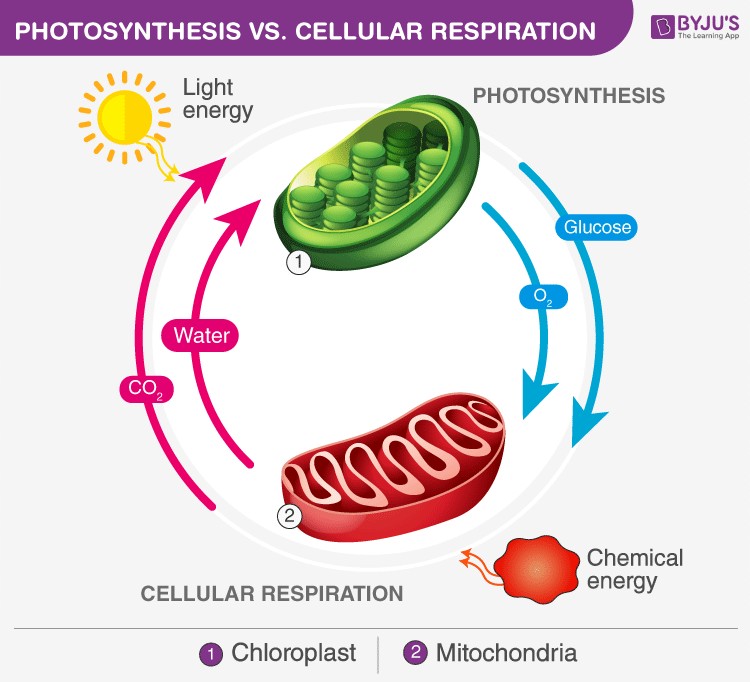Plants release oxygen as a byproduct of photosynthesis, a process crucial for life on Earth. We, in turn, breathe in this oxygen, allowing our cells to perform cellular respiration and generate the energy currency of life, ATP. These two fundamental biological processes, photosynthesis and cellular respiration, are interconnected and vital for maintaining the balance of life in our ecosystems.
Respiration and photosynthesis are complementary reactions, each playing a unique role in the cycle of energy and matter. In cellular respiration, oxygen and glucose are utilized to produce water and carbon dioxide, releasing energy in the process. Conversely, photosynthesis uses carbon dioxide and water, along with light energy, to synthesize glucose and release oxygen.
This reciprocal relationship is essential: photosynthesis provides the glucose and oxygen needed for cellular respiration, while cellular respiration produces the carbon dioxide and water used in photosynthesis. Neither process can function independently in the long run, highlighting their mutually beneficial dependence.
In many ways, photosynthesis and cellular respiration are often described as “reverse” processes. Photosynthesis is an anabolic pathway, building complex molecules from simpler ones and storing energy. Cellular respiration, on the other hand, is a catabolic pathway, breaking down complex molecules to release energy. Let’s delve deeper into the differences that distinguish these two essential processes.
Key Differences Between Cellular Respiration and Photosynthesis
 Photosynthesis and Cellular Respiration
Photosynthesis and Cellular Respiration
Comparison table illustrating the key differences between photosynthesis and cellular respiration, highlighting their contrasting processes and reactants.
| Feature | Cellular Respiration | Photosynthesis |
|---|---|---|
| Occurrence | All living organisms | Phototrophs (green plants, algae, some bacteria) |
| Location | Mitochondria | Chloroplasts |
| Reactants | Glucose and Oxygen | Carbon Dioxide, Water, and Light Energy |
| Products | Carbon Dioxide, Water, and Energy (ATP) | Glucose, Oxygen, and Water |
| Process Type | Catabolic | Anabolic |
| Gas Exchange | Oxygen taken in, Carbon Dioxide released | Carbon Dioxide taken in, Oxygen released |
| Energy Role | Breaks down food to release energy | Synthesizes food by capturing energy |
| Energy Reaction | Exergonic (releases energy) | Endothermic (requires energy) |
| Light Requirement | Not required (occurs constantly) | Required (occurs in the presence of sunlight) |
| Chemical Equation | C6H12O6 + 6O2 → 6CO2 + 6H2O | 6CO2 + 6H2O → C6H12O6 + 6O2 |
Organisms and Location: Cellular respiration is a universal process, occurring in all living organisms, from the simplest bacteria to the most complex animals. This process primarily takes place in the mitochondria, often referred to as the “powerhouses of the cell.” Photosynthesis, however, is exclusive to phototrophs – organisms capable of producing their own food using light energy. This group includes green plants, algae, and certain bacteria. Photosynthesis occurs within chloroplasts, specialized organelles containing chlorophyll, the pigment that captures light energy.
Reactants and Products: The reactants and products of these processes are essentially reversed. Cellular respiration utilizes glucose (a sugar) and oxygen as reactants, transforming them into carbon dioxide, water, and energy in the form of ATP (adenosine triphosphate). Photosynthesis, conversely, uses carbon dioxide, water, and light energy to produce glucose and oxygen. Water is also a byproduct in photosynthesis.
Anabolic vs. Catabolic Processes: Photosynthesis is an anabolic process because it involves building complex molecules (glucose) from simpler ones (carbon dioxide and water). This process requires energy input, specifically light energy from the sun, and stores this energy in the chemical bonds of glucose. Cellular respiration is a catabolic process, breaking down complex molecules (glucose) into simpler ones (carbon dioxide and water). This breakdown releases the stored energy from glucose, making it available for the cell to use for various life processes.
Energy and Light Dependency: Cellular respiration is an exergonic reaction, meaning it releases energy. This process doesn’t directly require sunlight and occurs continuously in living cells to provide energy for their functions. Photosynthesis, on the other hand, is an endothermic reaction, requiring energy input to proceed. This energy is derived from sunlight, making photosynthesis dependent on light and thus occurring only during daylight hours or in the presence of artificial light sources.
Conclusion
Photosynthesis and cellular respiration are two fundamental biological processes that are intrinsically linked. While they are distinct in their mechanisms, locations, reactants, and products, they are ultimately complementary. Photosynthesis harnesses light energy to produce glucose and oxygen, which are then utilized by cellular respiration to release energy for life’s activities, producing carbon dioxide and water as byproducts, which are in turn used by photosynthesis. This elegant cycle underscores the delicate balance and interdependence of life on Earth, driven by the flow of energy and the transformation of matter through these two vital processes.
